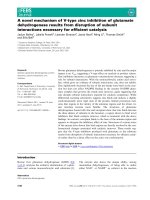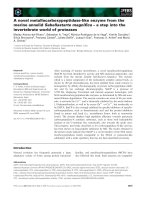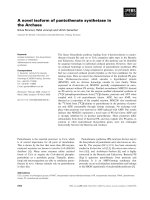A Novel Design of Antenna for the 3G Mobile Devices
Bạn đang xem bản rút gọn của tài liệu. Xem và tải ngay bản đầy đủ của tài liệu tại đây (373.77 KB, 7 trang )
<span class='text_page_counter'>(1)</span><div class='page_container' data-page=1>
A Novel Design of Antenna for the 3G Mobile Devices
Ha Quoc Anh
*, Nguyen Quoc Dinh
<i>Department of Fundamentals of Radio and Electronic Engineering, </i>
<i>Le Quy Don Technical University, Hanoi City, Vietnam </i>
<b>Abstract </b>
This paper proposes a novel structure of the inverted F antenna based on meandering and folding methods for the
monopole antenna placed on FR4 dielectric plate. The proposed antenna has compact size (21 mm × 14 mm ×
3.2 mm). Moreover, this antenna still offers enough wide bandwidth (VSWR ≤ 2), which covers 3G bandwidth.
Using the simulation program to optimize antenna structure and calculate the antenna parameters in order to
verify its applicability for the 3G mobile devices.
© 2015 Published by VNU Journal of Science.
Manuscript communication: received 04 May 2014, revised 29 April 2015, accepted 25 June 2015
Corresponding author: Ha Quoc Anh,
<i>Keywords:</i> 3G, Inverted F Antenna, Miniaturization of Antenna.
<b>1. Introduction </b>
Nowadays, with the rapid growth of
wireless means of communication, there is a
growing demand for mobile devices that are
small, thin, attractive, lightweight, and curvy.
To satisfy the above demand, it is necessary to
miniaturize mobile device’s components.
Especially, antenna, an essential part, is
miniaturized in order to put into the device.
Many studies and suggestions about typical
antenna structure for portable devices have been
published recently. D. Bonefacic [1] proposed a
design for a micro-strip antenna that works on
central frequency of 2.0 GHz and has very
small size (30 mm × 12.9 mm × 5 mm) but the
bandwidth of the proposed antenna is too
narrow (26 MHz). Y. Kim [2] proposed a
folded loop antenna system for new future
handsets. M. Karaboikis [3] proposed a
dual-printed inverted F antenna structure for terminal
devices. K. Sarabandi [4] proposed a method of
miniaturized size antenna as small as 0.05λ ×
0.05λ. M. Akbari [5] presented an approach to
optimize the antenna structure by creating a
planar inverted F antenna (PIFA). However, the
overall size of the proposed antennas in the
references is still quite large; therefore it is
difficult for the mobile device to miniaturize its
size for applications in MIMO system. In order
to overcome the said shortcomings, in the
reference document [6], an antenna with smaller
size (23 mm × 14 mm × 5 mm) is proposed which
can be applied for 3G mobile devices.
</div>
<span class='text_page_counter'>(2)</span><div class='page_container' data-page=2>
antenna. Next, we analyze the inverted F
antenna placed on a metallic plane representing
a mobile device. Then, it is possible to propose
a method to miniaturizing antenna structure and
to design a compact antenna with dimensions of
21 mm × 15 mm × 3.2 mm, which is smaller
than antennas in the reference [6]. Although its
height is only 3.2 mm but its bandwidth and
other technical parameters are still ensured.
This antenna structure can be placed into thin
mobile devices.
In order to match the antenna input
impedance with the feeder and to ensure its
bandwidth must be wide enough to cover the
3G bandwidth, the antenna structure is
optimized. Finally, the antenna parameters such
as input impedance, VSWR, radiation pattern
are calculated to validate the applicability of the
proposed antenna in 3G devices.
<b>2. The proposed antenna structure for 3G </b>
<b>mobile devices </b>
<i>2.1. Main requirements of antennas for 3G </i>
<i>mobile devices </i>
When design an antenna for the mobile
devices, bandwidth and the requirements of
antenna compact dimensions must be taken into
account. Normally, the 3G mobile devices have
the length, width and thickness of 110 mm, 60
mm, and 12 mm, respectively. Currently, the
3G mobile systems in Vietnam use frequencies
from 1.9 GHz to 2.17 GHz. Thus, the design
antenna for 3G mobile devices has to ensure the
requirements on compact size, bandwidth and
several following parameters:
● The antenna size must be small enough to
be placed in a mobile device, its height is less
than 5 mm, its length and its width are less than
40 mm;
● The input impedance of the antenna can
reach 50 Ω at the central frequency (to match
perfectly with the feeder);
● VSWR ≤ 2;
● The bandwidth of the antenna is large
enough: (≥ 10%, ≥ 200 MHz).
<i>2.2. A method of miniaturizing antenna structure </i>
Let’s consider the inverted F antenna
placed on a metallic plane (using copper),
with dimensions of 86 mm × 40 mm × 0.1
mm, that represents a mobile device, with
surveyed bandwidth from 1.8 GHz to 2.2
GHz. A FR4 dielectric plate is placed
between the antenna and the metallic plane.
In Fig. 1, the dimension of the FR4 dielectric
plate is 40 mm × 15 mm × 3.2 mm. In order
to miniaturize the size of the initial inverted F
antenna, it is possible to apply meandering,
folding and slotting methods [7] and apply
dielectric substance FR4 to form its structure.
In addition, in order to ensure the antenna
input impedance, it is needed to change the
current in the antenna by varying the distance
between the feeding point and the grounding
point and adding U, L shape strip-lines,
rectangular strip-lines.
</div>
<span class='text_page_counter'>(3)</span><div class='page_container' data-page=3>
Fig. 1. The antenna structure.
After many experiments, an optimized
antenna structure is chosen. The size of the
optimized antenna elements is shown in Table I.
Fig. 2. The structure of proposed antenna.
Antenna is connected with the metallic
plane by 2 points, the feeding point and the
grounding point. This antenna structure
<i>consists of copper strip-lines of width w</i>2 = 1
mm, thickness is 0.1 mm. The overall
dimensions of the antenna are chosen with 21
mm (length), 14 mm (width), and 3.2 mm
(height). A gap between the feeding point and
<i>the grounding point is l</i>5 = 9 mm. Except for the
strip-lines are connected to the metallic plane,
other strip-lines are fixed on the dielectric FR4
plate and parallel to the ground.
To choose the optimal parameters of
antenna as shown in Table I, we examine of the
effect of antenna size parameters to VSWR.
<i>2.3. Impact of VSWR when changing antenna </i>
<i>size parameters </i>
<i>2.3.1. Impact of VSWR when changing l3</i>
<i>Fig. 3. The effect of l3</i>to VSWR.
The results of calculating the dependence
<i>of parameter l3</i> on the VSWR is represented
in Fig. 3. For VSWR ≤ 2, when increasing the
<i>length l3</i>, the electrical length of monopole
antenna increases so that resonance frequency
and bandwidth of antenna decrease. In
<i>contrast, when reducing the length l3</i>, the
bandwidth of antenna increases but it does
not cover the bandwidth of 3G mobile
devices. As a result, in order to have
bandwidth of antenna cover the working
bandwidth of 3G mobile devices, it is
<i>necessary to select parameter l3</i> = 14.0 mm.
<i>W</i>
<i>L</i>
Antenna
Ground plane
Feeding point Grounding point
<i>h</i>
<i>l2</i>
<i>l<sub>3</sub></i>
<i>l1</i>
<i>l4</i>
<i>l5</i>
<i>s</i>
<i>l6</i>
<i>l7</i>
<i>w1</i>
<i>w3</i>
<i>z</i>
<i>x</i>
<i>y</i>
<i>l8</i>
<i>w2</i>
1.80 1.85 1.90 1.95 2.00 2.05 2.10 2.15 2.20
1.0
1.5
2.0
V
S
W
R
Frequency [GHz]
3G bandwidth
(270 MHz)
<i>l3</i>= 14.5 mm
<i>l3</i>= 14.0 mm
</div>
<span class='text_page_counter'>(4)</span><div class='page_container' data-page=4>
<i>2.3.2. Impact of VSWR when changing l5</i>
<i>Fig. 4. The effect of l5</i>to VSWR.
The results of calculating the dependence of
<i>parameter l5</i> on the VSWR is represented in
Fig. 4. For VSWR ≤ 2, when increasing the
<i>length l5</i>, the distance between the feeding point
and the grounding point increases, therefore
current in the antenna changes. This makes
resonance frequency and bandwidth of antenna
increase. In contrast, when reducing the length
<i>l5</i>, the bandwidth of antenna decreases.
However, in both cases, bandwidth of antenna
does not cover the bandwidth of 3G mobile
<i>devices. Therefore, parameter l5</i> must be
selected with optimal value is 8.0 mm.
<i>2.3.3. Impact of VSWR when changing l6</i>
<i>Fig. 5. The effect of l6</i>to VSWR.
<i>In Fig. 5, similar to the parameter l3</i>, when
<i>increasing the length l6</i>, the electrical length of
monopole antenna increases, therefore
resonance frequency and bandwidth of antenna
decrease. In contrast, when reducing the length
<i>l6</i>, the bandwidth of antenna increases but it
does not cover the bandwidth of 3G mobile
devices (with VSWR ≤ 2). Therefore,
<i>parameter l6</i> must be selected with optimal
value is 11.0 mm.
<i>2.3.4. Impact of VSWR when changing l8</i>
<i>Fig. 6. The effect of l8</i>to VSWR.
The results of calculating the dependence of
<i>parameter l8</i> on the VSWR is represented in
Fig. 6. Similar to other parameters, when
<i>changing the length of l8</i> compared with the
optimal value, the bandwidth of antenna (with
VSWR ≤ 2) does not cover the bandwidth of
<i>3G mobile devices. Therefore, parameter l8</i>
must be selected with optimal value is 2.8 mm.
Similarly, when analyzing the effects of
changing other parameters to VSWR, the
optimal dimensions of the antenna are chosen,
as shown in Table I.
1.80 1.85 1.90 1.95 2.00 2.05 2.10 2.15 2.20
1.0
1.5
2.0
V
S
W
R
Frequency [GHz]
3G bandwidth
(270 MHz)
<i>l5</i>= 8.5 mm
<i>l5</i>= 8.0 mm
<i>l5</i>= 7.5 mm
1.80 1.85 1.90 1.95 2.00 2.05 2.10 2.15 2.20
1.0
1.5
2.0
V
S
W
R
Frequency [GHz]
3G bandwidth
(270 MHz)
<i>l6</i>= 11.5 mm
<i>l6</i>= 11.0 mm
<i>l6</i>= 10.5 mm
1.80 1.85 1.90 1.95 2.00 2.05 2.10 2.15 2.20
1.0
1.5
2.0
V
S
W
R
Frequency [GHz]
3G bandwidth
(270 MHz)
<i>l8</i>= 3.2 mm
<i>l8</i>= 2.8 mm
</div>
<span class='text_page_counter'>(5)</span><div class='page_container' data-page=5>
Table I. The size of the proposed antenna (MM)
<b>Parameters Value Parameters Value Parameters Value </b>
<i>L </i> 80 <i>w2</i> 1 <i>l4</i> 7
<i>W </i> 40 <i>w3</i> 21 <i>l5</i> 8
<i>h</i> 3.2 <i>l1</i> 6 <i>l6</i> 11
<i>s</i> 1 <i>l2</i> 7 <i>l7</i> 6.5
<i>w1</i> 15 <i>l3</i> 14 <i>l8</i> 2.8
TAJ
<i>2.4. Simulated results of the proposed antenna </i> Simulated results in the input impedance and
VSWR of the optimized antenna are shown in
Fig. 7 and Fig. 8, respectively. The radiation
<i>pattern in the xz and yz planes for the frequencies </i>
of 1.90 GHz, 2.02 GHz and 2.17 GHz are plotted
in Fig. 9.
(a)
(b)
Fig. 7. Input impedance of the proposed antenna.
Fig. 8. VSWR of the proposed antenna.
10 25 50 100 250
-10j
10j
-25j
25j
-50j
50j
-100j
100j
-250j
250j
2.02 GHz
(40 Ω)
1.80 1.85 1.90 1.95 2.00 2.05 2.10 2.15 2.20
1.0
1.5
2.0
V
S
W
R
Frequency [GHz]
285 MHz
1.885 GHz <sub>2.180 GHz</sub>
3G bandwidth
(270 MHz)
-16
-12
-8
-4
0
4
0
30
60
90
120
150
180
210
240
270
300
330
-16
-12
-8
-4
0
4
yz plane
xz plane
-16
-12
-8
-4
0
4
0
30
60
90
120
150
180
210
240
270
300
330
-16
-12
-8
-4
0
4
</div>
<span class='text_page_counter'>(6)</span><div class='page_container' data-page=6>
<b>(c) </b>
<i>Fig. 9. Antenna radiation pattern (a) f = 1.90 GHz, </i>
<i>(b) f = 2.02 GHz, (c) f = 2.17 GHz. </i>
In Fig. 7, the antenna input impedance can
reach approximately 40 Ω at the resonant
frequency of 2.02 GHz. In Fig. 8, the optimized
antenna bandwidth is 285 MHz (14 %
compared with the central frequency), VSWR ≤
2. The results show that the proposed antenna
structure has compact size (21 mm × 14 mm ×
3.2 mm), relatively wide bandwidth and can be
applied to antennas for 3G mobile devices.
<i>In Fig. 9, the solid line is for the yz plane, </i>
<i>dashed one is for the xz plane. The antenna </i>
radiation pattern is relatively equal in the
whole bandwidth. The maximum gain can be
<i>achieved in the yz plane. At the central </i>
frequency of 2.02 GHz, antenna gain reaches
its maximum of 3.92 dBi.
The peak gain of the antenna within the
bandwidth is shown in Fig. 10. As can be seen,
the antenna gain is relatively equal and is
greater than 3.3 dBi in the whole bandwidth of
the device.
Fig. 11 illustrates the distribution of current
on the antenna surface. In Fig. 11, amperage is
highest at the feeding point and then the
amperage gradually decrease towards strip-line
<i>l3 and rectangular strip-lines l2 × l1, l6 × l7</i>.
Simulated results show that the proposed
antenna structure can be applied well in 3G
mobile devices.
Fig. 10. Antenna maximum gain in yz plane.
<b>Fig. 11. Distribution of current on the proposed antenna. </b>
<b>3. Conclusions </b>
This paper proposed a miniaturized antenna
structure for 3G mobile devices based on
meandering and folding methods for the
monopole antennas using inverted F antenna.
Some achieved results are:
i) Compact antenna structure of 21 mm ×
14 mm × 3.2 mm is small enough to be placed
in a mobile device;
-16
-12
-8
-4
0
4
0
30
60
90
120
150
180
210
240
270
300
330
-16
-12
-8
-4
0
4
yz plane
xz plane
1.80 1.85 1.90 1.95 2.00 2.05 2.10 2.15 2.20
2.0
2.5
3.0
3.5
4.0
A
n
te
n
n
a
P
ea
k
G
ai
n
[
d
B
i]
Frequency [GHz]
3.92 dBi
3.30 dBi
</div>
<span class='text_page_counter'>(7)</span><div class='page_container' data-page=7>
ii) Relatively wide bandwidth 285 MHz (14
%, VSWR ≤ 2), covers the 3G mobile
bandwidth;
iii) Antenna peak gain is relatively equal
and is greater than 3.3 dBi in the whole
bandwidth of the 3G mobile devices.
In the future, the authors continue to
propose methods of miniaturized the antenna
structure to reduce the antenna thickness while
ensuring the bandwidth requirements and other
technical parameters.
<b>References </b>
[1] D. Bonefacic, J. Bartolic, “Small Antennas:
Miniaturization Techniques and Applications,”
ATKAFF 53(1), 20–30, 2012.
[2] Y. Kim, H. Morishita, Y. Koyanagi, K. Fujimoto, “A
Folded Loop Antenna System for Handsets
Developed and Based on the Advanced Design
<i>Concept,” IEICE Trans. Commun., vol.E84-B, no.9, </i>
pp. 2468-2475, Sep. 2001.
[3] M. Karaboikis, C. Soras, G. Tsachtsiris, V. Makios,
“Compact Dual-Printed Inverted-F Antenna Diversity
<i>Systems for Portable Wireless Devices,” IEEE </i>
<i>Antennas and Wireless Propagation Letters</i>, Vol.3,
pp. 9-14, 2004.
[4] K. Sarabandi, R. Azadegan, H. Mosallaei, and J.
Harvey, “Antenna miniaturization techniques for
applications in compact wireless transceivers,”
<i>XXVIIth General Assembly of URSI, Maastricht, </i>
The Netherlands, Aug. 17-24, 2002.
[5] M. Akbari, C. Ghobadi and J. Nourinia, “Internal
multiband PIFA antenna for
GPS/DCS/PCS/UMTS/WLAN operation in the
<i>mobile device,” IEICE Electronic Express, Vol.6, </i>
No.24, Dec. 2009.
[6] H. Q. Anh, N. Q. Dinh, D. Q. Trinh, “A method to
miniaturize antenna structure for the 3G mobile
device,” The 2013 International Conference on
Advanced Technologies for Communications
(ATC'13), pp.191-194, Oct. 2013.
[7] K. Skrivervik, J. F. Zurcher, O. Staub and J. R.
Mosig, “PCS antenna design: The Challenge of
<i>Miniaturization,” IEEE Antennas and Propagation </i>
</div>
<!--links-->









